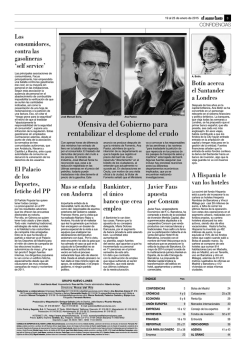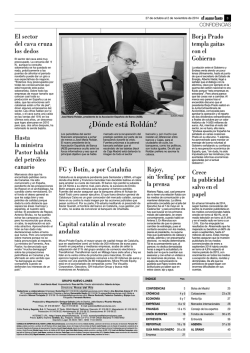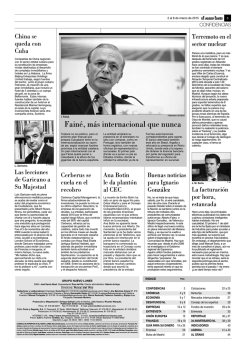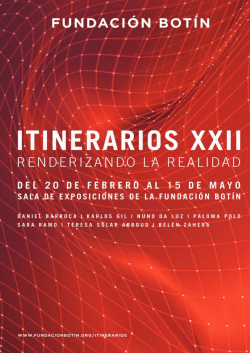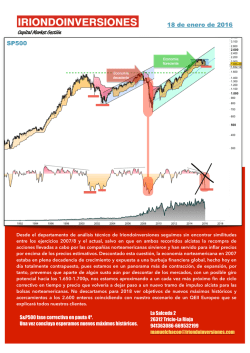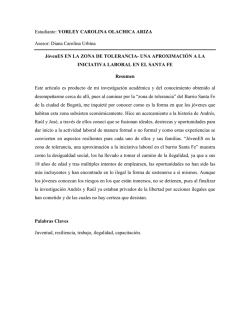
Newsletter Noviembre 2016
News Botín Nouvelles Botín Nieuws Botín Notícias Botín Botín Nieuwss Noticias Botín News Botín Nieu Buñuelos de viento ● ● ● Número 137. NOVIEMBRE 2016 ● ● [Wind Fritters] L saber hacer y los buenos modos caracterizan la trayectoria del restaurante Botín que, a lo largo de su historia, ha sabido irse adaptando a los hábitos de sus clientes, creciendo con ellos, cambiando sin perder su esencia ni su identidad. En este camino la bodega Viña Salceda ha sido un fiel compañero, y el Salceda Crianza, el vino de la casa, siente el orgullo de un pasado y un futuro prometedor. También la bodega riojana ha experimentado algunos cambios. Si hace tiempo que no prueba un Salceda Crianza, no lo dude: le sorprenderá. Es un vino que refleja lo que encierra Elciego, una zona productora prestigiosa que por la singularidad de sus viñas, clima y tierra, es capaz de ofrecernos un vino cálido y amable que está conquistando los paladares más inquietos. Tempranillo, viñedos maduros, clima moderado, tierras arcillosas y calcáreas,… Salceda es también el fruto del trabajo del hombre, tanto en la tierra como en la bodega. Los viñedos son cuidadosamente cultivados de un modo tradicional: se labra la tierra en lugar de utilizar cualquier herbicida, y las tareas, desde la poda hasta la vendimia, se hacen a mano, de una manera razonable y sostenible. La elaboración, tradicional y artesanal, está basada en preservar y revelar las cualidades de la uva con el mayor cuidado posible. El objetivo: lograr que cada una de las botellas de Salceda Crianza sean únicas y encierren la esencia de Elciego. La mejor compañía para la cocina cálida que se elabora en Botín. Expertise and capability characterise the trajectory of Botín Restaurant, which throughout its history has understood how to adapt to the habits of its clients, growing with them, changing without losing its essence or identity. Along the way theViña Salceda winery has been a trusty companion, and Salceda Crianza, the house wine, feels the pride of its past and of its promising future. This Rioja winery has also undergone a few changes. If it has been a while since you last tasted the Salceda Crianza, do not hesitate: you will be pleasantly surprised. The wine reflects all the goodness of Elciego, a prestigious wineproducing area that thanks to its unique vines, climate and soil is capable of offering us a heartening, friendly wine that is winning over the most demanding palates. Tempranillo grapes, mature vineyards, a moderate climate, clay and chalk soil… Salceda is also the result of man’s work, both on the land and in the wine cellar. The vineyards are painstakingly cultivated in the traditional manner: the soil is tilled instead of using any herbicide and the tasks, from pruning to harvest, are performed by hand, in a reasonable and sustainable way. The traditional and artisan production is based on preserving and revealing the qualities of the grape as carefully as possible.The goal: to make each one of the bottles of Salceda Crianza unique to contain the essence of Elciego. The best pairing for the heartwarming cuisine we prepare at Botín. RESTAURANTE BOTÍN Calle Cuchilleros, 17 - 28005 Madrid Tfnos de reservas.: 913 664 217 - 913 663 026 e-mail de reservas: [email protected] www.botin.es © 2016. Todos los derechos reservados. Fax de reservas: 913 668 494 Ya hace días que, en nuestras pastelerías, podemos verlos. Ocurre siempre cuando se acerca el día de Todos los Santos, son los buñuelos de viento… que ojalá fueran ligeros como el viento, pero no es el caso. De todas maneras dice el refrán que “Una vez al año no hace daño”, así que disfrutémoslos. For some days now we have been seeing them in our pastry shops. The wind fritters are always there when All Hallows’ day approaches… it would be great if they were as light as the wind, but this is not the case. In any event, the adage says that “once a year won’t do any harm”, so let’s enjoy them. Son todo un clásico de la repostería tradicional. Se trata de una pasta hecha a base de harina, leche, huevo y levadura, que se fríe en abundante aceite y se suele rellenar después de crema, nata, chocolate, etc. They are a classic of traditional pastry-making. The dough is made from flour, milk, egg and yeast, then fried in abundant oil and later filled with custard, cream, chocolate, etc. La historia dice qu el origen de esta “delicia” es árabe. Se piensa que surgieron en un pueblo de Málaga, Almogía. Allá por el 1090, la villa estaba siendo sometida a un cerco por parte de las tropas de Mohamed ben Abad Al Motamid. Las provisiones escaseaban y no había leña para los hornos, así que a un panadero llamado Abdelaziz ben Drisi el Jabazún, se le ocurrió preparar unas tortitas a base de agua y harina y las subió a lo alto del castillo para freirlas en el aceite hirviendo de los calderos que usaban los soldados para arrojar al enemigo. Y esos fueron los primeros buñuelos de la historia, aunque hay otras teorías (de las que ya hemos hablado en otra ocasión) que atribuyen un origen romano e incluso francés a este dulce. Según esto, una vez más se hace bueno el dicho de “De la necesidad nace la virtud”. The story goes that the origins of this “delicacy” are Arabic.They are thought to come from a town in Malaga, Almogia. Around 1090, the town was being besieged by the troops of Muhammad ibn Abbad alMu’tamid. Provisions were becoming scarce and there was no firewood for the ovens, so a baker called Abdelaziz ben Drisi el Jabazun had the idea of preparing some patties from water and flour and taking them to the top of the castle to fry them in the boiling oil the soldiers used for throwing down on the enemy. And those were the first fritters in history, although there are other theories (of which we have spoken on another occasion) that give this sweet a Roman or even a French origin. This is once again confirmation of the saying: “to make a virtue of need”. News Botín Nouvelles Botín Nieuws Botín ● ● La calle más larga de Madrid Greguerías [Madrid´s longest street] [Greguerías] La florista de la canción, ya saben… “Por la calle de Alcalá, con la falda almidoná y los nardos apoyaos en la cadera…” llevaría calzado cómodo, la mujer, porque nada menos que 10,5 kilómetros tiene la susodicha calle de Alcalá, la más larga de la capital. Comienza en la Puerta del Sol y llega hasta Ciudad Lineal, atravesando cinco distritos madileños durante su recorrido y albergando monumentos tan emblemáticos como la Fuente de Cibeles o la Puerta de Alcalá (1778) y 544 portales. The florist in the song that goes “Por la calle de Alcalá, con la falda almidoná y los nardos apoyaos en la cadera…” (Along Alcalá street in my starched skirt and the tuberoses resting on my hip…) must have been wearing comfortable footwear, the poor woman, because Alcalá street is no less than 10.5 kilometres long, the longest in the capital. It begins in Puerta del Sol and reaches as far as Ciudad Lineal, crossing five of Madrid’s districts in its route and containing some of the most emblematic monuments, such as the Cibeles Fountain or the Puerta de Alcalá (1778), plus 544 portals. Se trata de una calle muy antigua que nació en plena época del Madrid de los Austrias (siglo XV) por la necesidad de prolongar la calle Mayor hasta unirla con el Camino de Aragón. En tiempos fue cañada real. This is a very old street, founded at the height of Habsburg Madrid (15th century) as a result of having to extend Calle Mayor to link it up with the Camino de Aragón. In other times it was a royal herding path. Durante mucho tiempo se denominó calle de los Olivares por los muchos olivos que flanqueaban su recorrido, hasta que Isabel II mandó talarlos porque servían de escondrijo a muchos malhechores que atracaban a los que por allí pasaban. En el siglo XIX en ella estaban los más importantes cafés de tertulias de Madrid ( Café de Fornos y Café Suizo) y en el XX, es cuando se produce su mayor crecimiento a causa del ensanche , convirtiéndose en lo que es hoy: la calle más larga de Madrid. For a long time it was called calle de los Olivares for the many olive trees that flanked its route, until Isabel II ordered them to be cut down because they were being used as hiding places by many malefactors who held up the passers-by. In the 19th century it was the site of Madrid’s most important cafés where people gathered to chat at the tertulias (Café de Fornos and Café Suizo). The street saw its greatest growth in the 20th century when this part of the city was enlarged, to become what it is today: Madrid’s longest street. Se trata de textos breves, generalmente muy cortos, que expresan, de forma aguda y original, pensamientos filosóficos, humorísticos, pragmáticos, líricos o de cualquier otra índole. Se considera a Ramón Gómez de la Serna es el creador de este género literario Este carismático escritor madrileño, nacido en 1888, era un habitual de nuestra casa y llevaba la voz cantante en las tertulias que se organizaban en el ya desaparecido Café de Pombo y también en Botín. Su curioso sentido del humor, algo excéntrico, le llevó en cierta ocasión a pronunciar una conferencia subido en un trapecio del circo y, otro día, invitado a hablar en la Academia de Jurisprudencia, leyó él mismo una carta en la que se disculpaba por no poder asistir al acto al encontrarse enfermo. Gómez de la Serna salía por Madrid a la caza de «greguerías»; cuando la inspiración le llegaba, se dirigía a la más cercana de las cuatro habitaciones que tenía alquiladas en diferentes zonas de Madrid, todas ellas bien provistas de mesa, papel, pluma y tinteros. Cabe destacar que siempre utilizaba tinta roja, pues consideraba que, así, «la transfusión al papel es más sincera, lleno mis plumas de mi propia sangre». Gómez de la Serna dedica varias de sus famosas greguerías a nuestro restaurante: «Botín es el gran restaurante donde se asan las cosas nuevas en las cazuelas antiguas.» «Botín parece que ha existido siempre y que Adán y Eva han comido allí el primer cochifrito que se guisó en el mundo.» «En el viejo Botín de la vieja calle de Cuchilleros, también está el lechoncito, el conmovedor lechoncito, ante el que lloraríamos como si se tratase de nuestros hijos pues llega a parecernos que nos van a decir: Bautizados, tantas pesetas, y sin bautizar tantas menos.» «A Botín se va a celebrar las bodas de oro, las de plata, las de diamante y hasta las fósiles.» Las Greguerías fueron reunidas en varios volúmenes y traducidas a diversos idiomas, así como publicadas en diferentes periódicos y revistas del mundo. Greguerias, a form of aphorism, are generally very short one-liners that in a sharp and original way express thoughts that may be philosophical, humorous, pragmatic, lyrical or of any other kind. Ramón Gomez de la Serna is considered to be the creator of this literary genre. This charismatic writer born in Madrid in 1888 was a regular of our house and always played a leading role in the tertulias, the social gatherings organised in the now vanished Café de Pombo and also in Botín. His curious and somewhat eccentric sense of humour led him on a certain occasion to give a lecture from a circus trapeze and, on another day, invited to speak at the Academy of Jurisprudence, he read out in person a letter in which he apologised for not being able to attend the function by reason of illness. Gomez de la Serna used to wander around Madrid hunting for «greguerias» or aphorisms; when inspiration struck him, he headed for the nearest of the four rooms he had rented in different parts of Madrid, all of them well kitted out with a desk, paper, pen and inkwells.We should point out that he always used red ink, for he considered that in this way «the transfusion to the paper is more sincere. I fill my pens with my own blood». Gomez de la Serna dedicated several of his famous greguerías to our restaurant: «Botín is the great restaurant where they cook new things in old pots.» «Botín seems like it has always existed and that Adam and Eve ate there the first sautéed lamb ever cooked in the world.» «In the old Botín in the old street of Cuchilleros, there is also the suckling pig, the heartrending suckling pig, before which we could cry as if it were our own child, for it seems to us that it will tell us: If baptised, so many pesetas, and if not baptised, so many fewer.» «One goes to Botín to celebrate ones golden wedding, silver wedding, diamond wedding and even fossil wedding.» Nieuws Botín Nachrichten Botín Notizie Botín The Greguerías were collected in several volumes and translated into various languages as well as published in different newspapers and magazines around the world. ● ●
© Copyright 2026

